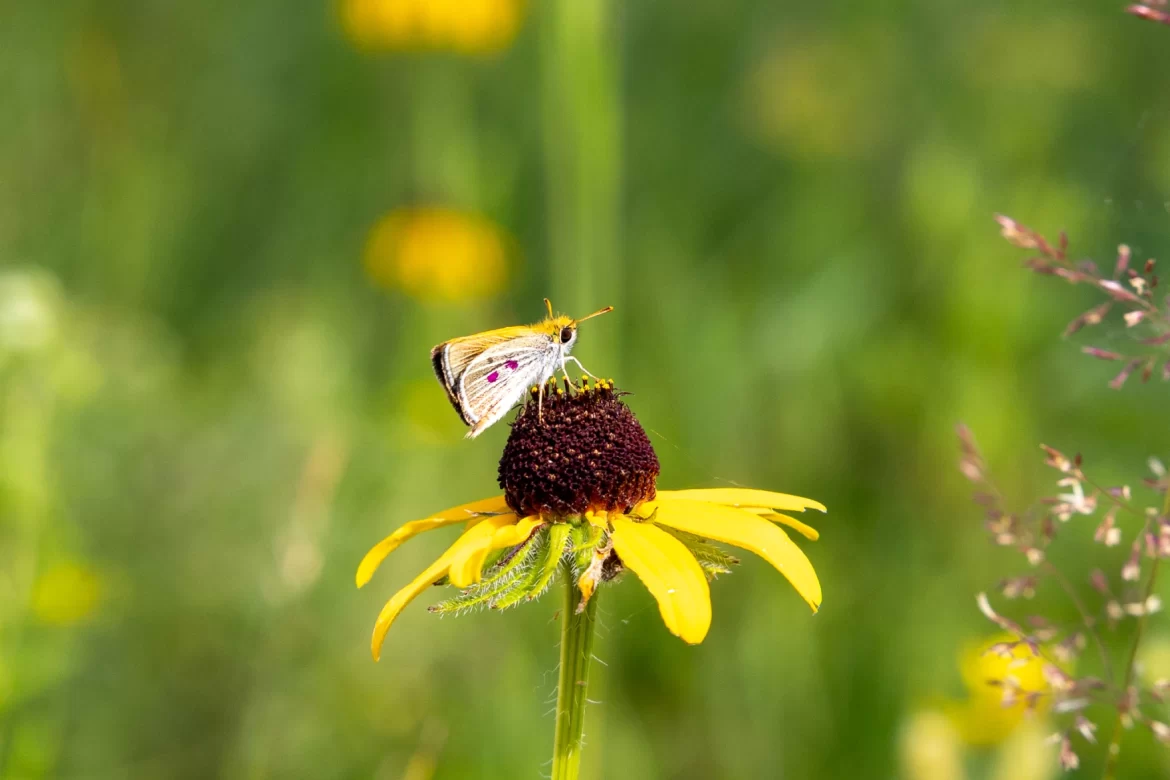The Poweshiek skipperling has disappeared from most of Michigan’s prairies. Now scientists are raising them in zoos for release back into the wild.

A Poweshiek skipperling is on a black-eyed Susan. The purple spots on the wings mark it as one of this year’s releases. Image: Ruth Thornton
By Ruth Thornton
Standing next to a converted hoop house in one of the back areas of John Ball Zoo in Grand Rapids, David Pavlik points to a line of small cloth-covered cages filled with yellow black-eyed Susans and small orange butterflies.
“These cages out here are females that have already bred in the facility,” Pavlik said. “They’re out here in the sun laying eggs.”
Pavlik, a research assistant with Michigan State University, is part of an international partnership racing to save a small, inconspicuous butterfly known as the Poweshiek skipperling that was once so common in Midwest prairies that collectors largely ignored them.
Then their populations plummeted, and now they’re found in only a handful of sites in Manitoba and Michigan.
Zoos in Michigan, Minnesota and Canada, federal agencies, private conservation organizations and local governments are working together to learn how to successfully breed the species and release adult butterflies back into the wild.

Cale Nordmeyer is getting ready to release one of the butterflies. Image: Ruth Thornton
John Ball Zoo started with just 32 caterpillars three years ago, and efforts have been so successful that so far this year more than 1,300 have been released.
It was a close call – in 2022, only nine or 10 of the butterflies were found in the state, Pavlik said.
“When you get to population levels that low, there’s really not much of a chance for them to bounce back on their own,” he said. “That’s where we come in.”
The butterflies are out on the grasslands for only three weeks in July, and each adult lives for only four to six days.
“I tell people I work with butterflies,” Pavlik said. “But really, I should tell them that I work with caterpillars.”
The Poweshiek skipperling is like a canary in the coal mine for the habitats it occurs in.
“We can use the species to tell us if the environments where they live are healthy, or if they’re not,” Pavlik said. “When Poweshieks are declining so rapidly, that’s kind of telling us that something is off in the environment and it’s not the way it should be.”
While the work of the zoo is essential for the species to survive, Pavlik says, so is maintaining its habitat.
“If the habitat is not there for them,” Pavlik said. “It doesn’t matter how many we release, it’s not going to work.”
In recent weeks, butterflies have emerged almost every day, and someone from the zoo drives them to their release sites in Southeast Michigan.
The Poweshiek skipperlings occur in a type of grassy wetland called prairie fen.
“They’re very rare habitats. They support some of the most biologically diverse areas in all of Michigan,” said Cale Nordmeyer, a butterfly conservation specialist with the Minnesota Zoo who is helping with the release efforts.
Prairie fens also provide benefits for people such as flood mitigation and water filtration.
Nordmeyer said people walking in these sites often don’t understand they could be inadvertently trampling the habitat. To prevent damage to the butterflies and their eggs, scientists have requested the exact release sites to be kept secret.
Faith Kuzma, a field conservation coordinator at John Ball Zoo, has just made the trek to the release site. She said with the butterflies’ short life span, every day counts.
“We want to get them out here as soon as possible so that they have time to breed with any wild individuals, lay any eggs that they might have so that they’re having the most impact,” she said.
At the site of a recent release, biologists had found only two Poweshiek skipperlings a few years ago, Nordmeyer said. The butterfly has vanished completely from other locations.
“And now just in the time that we’ve been doing this release, we’ve seen several dozen butterflies that we didn’t just put out,” he said. Those butterflies are probably descendants of ones released last year or even the year before.
This is a milestone year in Michigan as biologists work to re-introduce the Poweshiek to one of the sites they’ve previously disappeared from, Nordmeyer said.
They won’t know if their efforts to restore the butterfly populations at those locations are successful until next year.
“This might be our first little baby step towards recovery for Poweshiek, not just maintenance, but recovery and seeing a self-sustaining future for this butterfly,” Nordmeyer said. “I can’t tell you how hopeful and excited I am to see this change.”
Ruth Thornton is an environmental reporting intern in a collaboration with WKAR Radio and the Knight Center for Environmental Journalism.
